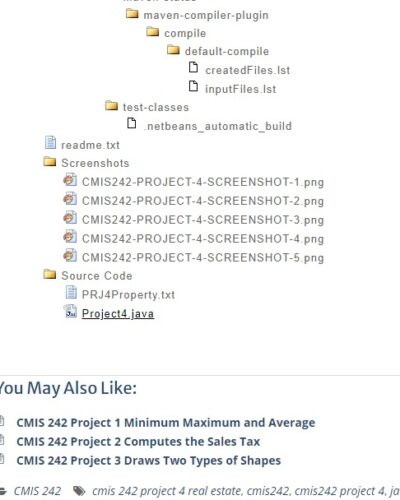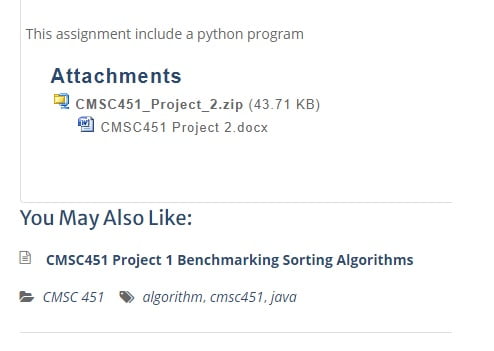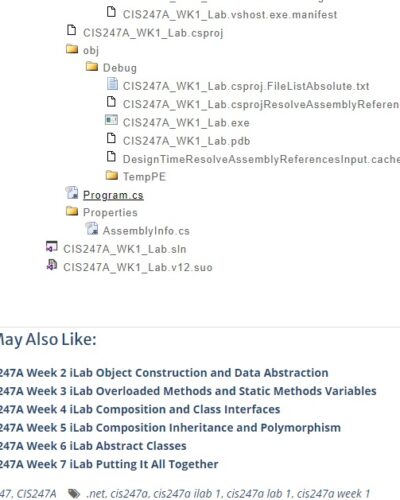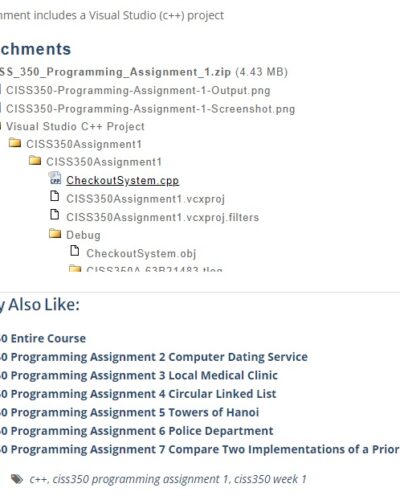
ACC 565 ACC565 ACC/565 ENTIRE COURSE HELP – STRAYER UNIVERSITY
$149.99$275.00
ACC 565 ACC565 ACC/565 ENTIRE COURSE HELP – STRAYER UNIVERSITY
ACC 565 Final Exam Guide
ACC 565 Midterm Exam Guide
ACC 565 Week 10 Assignment 4 Tax-Planning Client Letter on Irrevocable Trusts, Gift Tax, and Estate Tax
ACC 565 Week 2 Assignment 1 Client Letter (2 Papers)
ACC 565 Week 4 Assignment 2 Constructive Dividends, Redemptions, and Related Party Losses (2 Papers)
ACC 565 Week 7 Assignment 3 Reorganizations and Consolidated Tax contains (2 Papers)
Description
ACC 565 ACC565 ACC/565 ENTIRE COURSE HELP – STRAYER UNIVERSITY
ACC 565 Final Exam Guide
ACC 565 Midterm Exam Guide
ACC 565 Week 10 Assignment 4 Tax-Planning Client Letter on Irrevocable Trusts, Gift Tax, and Estate Tax
ACC 565 Week 2 Assignment 1 Client Letter (2 Papers)
ACC 565 Week 4 Assignment 2 Constructive Dividends, Redemptions, and Related Party Losses (2 Papers)
ACC 565 Week 7 Assignment 3 Reorganizations and Consolidated Tax contains (2 Papers)
ACC 565 ACC565 ACC/565 ENTIRE COURSE HELP – STRAYER UNIVERSITY
ACC 565 Final Exam Guide
Question 1
Barbara sells a house with an FMV of $170,000 to her daughter for $120,000. From this transaction, Barbara is deemed to have made a gift (before the annual exclusion) of
Question 2
If a state has adopted the Revised Uniform Principal and Income Act, which of the following statements is correct?
Question 3
Jackson and Tanker Corporations are members of an affiliated group. The two corporations have been affiliated since they were formed last year. Both corporations have always used a calendar year as their tax year. Tanker, the subsidiary, has a separate return year NOL of $14,000 from last year. Jackson Corporation has a separate return year NOL of $16,000 from last year. Commencing this year, the two corporations filed a consolidated tax return. The NOLs can be carried over
Question 4
Virginia gave stock with an adjusted basis of $8,000 and an FMV of $10,000 to Carmen. No gift tax was paid on the transfer. Carmen then sold the stock for $9,000. The gain or loss Carmen will recognize on the sale is
Question 5
If a partnership chooses to form an LLC, under the check-the-box rules, and assuming no elections are made, the entity will be taxed as
Question 6
Revocable trusts means
Question 7
Identify which of the following statements is true.
Question 8
Identify which of the following statements is true.
Question 9
Cactus Corporation, an S Corporation, had accumulated earnings and profits of $100,000 at the beginning of 2009. Tex and Shirley each own 50% of the stock and have a basis in their stock of $50,000 on January 1, 2009. Cactus does not make any distributions during 2009, but had $200,000 of ordinary income. In 2010, ordinary income was $100,000 and distributions were $100,000. What is Tex’s basis at January 1, 2011?
Question 10
Tax return preparers can be penalized for the following activities except
Question 11
An intervivos trust may be created by all of the following except
Question 12
Identify which of the following statements is true.
Question 13
Michael died in 2013 with a taxable estate and estate tax base of $6,000,000. Michael’s estate owed no state death taxes. Michael’s estate includes $250,000 of income in respect of a decedent (IRD), none of which is received by his surviving spouse. His estate had no DRD. The estate collects $200,000 of the IRD during its current tax year. The Sec. 691(c) deduction for the estate in current year is
Question 14
Which of the following corporations is entitled to join in a consolidated tax return without making a special election?
Question 15
Susan contributed land with a basis of $6,000 and an FMV of $10,000 to the SH Partnership two years ago to acquire her partnership interest. This year, the land is distributed to Harry when its FMV is $11,000. No other distributions have been made since Susan became a partner. When the land is distributed, the partnership’s basis in the land immediately before distribution is increased by
Question 16
What is the penalty for a tax return preparer who willfully attempts to understate taxes, or intentionally disregards the tax rules and regulations?
Question 17
When computing the partnership’s ordinary income, a deduction is allowed for
Question 18
Identify which of the following statements is true.
Question 19
A consolidated return’s tax liability is owed by
Question 20
Terry files his return on March 31. The return shows taxes of $6,000, and Terry pays this entire amount when he files his return. By what time must he file a claim of refund?
Question 21
The IRS provides advice concerning an issue that arises during an audit by issuing
Question 22
In computing the ordinary income of a partnership, a deduction is allowed for
Question 23
Damitria transfers her rights in a $100,000 insurance policy on June 1 to Tremayne. The policy has a cash value of $9,000 and an interpolated terminal reserve of $8,500. The annual policy premium of $12,000 had been paid on January 1. Damitria’s gift (before the annual gift tax exclusion) to Tremayne is
Question 24
Diana Corporation owns stock of Tomika Corporation. For Diana and Tomika to qualify for the filing of consolidated returns, at least what percentage of Tomika’s total voting power and total value of stock must be directly owned by Diana?
Question 25
The executor or administrator is responsible for all the following estate duties except
ACC 565 ACC565 ACC/565 ENTIRE COURSE HELP – STRAYER UNIVERSITY
ACC 565 Midterm Exam Guide
Question 1
Identify which of the following statements is false.
Question 2
Which of the following transactions does nothave the potential of creating a constructive dividend?
Question 3
The citation “Reg. Sec. 1.199-2” refers to
Question 4
Bruce receives 20 stock rights in a nontaxable distribution. The stock rights have an FMV of $5,000. The common stock with respect to which the rights are issued has a basis of $4,000 and an FMV of $120,000. Bruce allows the stock rights to lapse. He can deduct a loss of
Question 5
Identify which of the following statements is true.
Question 6
A corporation cannot reasonably accumulate earnings to
Question 7
Small case procedures of the U.S. Tax Court requires that the amount in dispute not exceed
Question 8
For purposes of determining current E&P, which of the following items cannot be deducted in the year incurred?
Question 9
What are the consequences of a stock redemption to the distributing corporation?
Question 10
Under a plan of complete liquidation, Coast Corporation distributes land with a $300,000 adjusted basis and a $400,000 FMV to William, a 25% shareholder. William has a $200,000 basis in his Coast stock. The land is inventory in the hands of Coast Corporation. Coast Corporation must recognize
Question 11
The phrase “Entered under Rule 155” indicates that
Question 12
You need to locate a recent tax case that was tried in a Federal district court. The decision is an “unreported” decision. This means the decision was
Question 13
When using the Bardahl formula, an increase in accounts payable (while holding purchases and operating expenses constant) has which of the following effects on the working capital
Question 14
Which of the following steps, related to a tax bill, occurs first?
Question 15
Dexer Corporation is owned 70% by Amy and 30% by Brad. Dexer Corporation owns Eagle Corporation stock with a $50,000 adjusted basis and a $30,000 FMV. The stock is not disqualified property. As part of a complete liquidation, the Eagle Corporation stock is distributed to Amy. Amy’s basis in her Dexer stock is $40,000. Dexer Corporation will recognize
Question 16
Which of the following requirements must be met for a redemption to be treated as substantially disproportionate?
Question 17
During the course of an audit, a CPA discovers an error in a prior return. According to the Statements on Standards for Tax Services, the CPA should
Question 18
Which of the following is not a condition that permits a stock redemption to be treated as a sale?
Question 19
Carolyn transfers property with an adjusted basis of $50,000 and an FMV of $60,000 in exchange for Prime Corporation stock in a Sec. 351 transaction. Carolyn’s basis in the stock is
Question 20
Tia owns 2,000 shares of Bass Corporation common stock with an $80,000 basis. Bass distributes a nontaxable preferred stock dividend. When the preferred stock is distributed, it has an FMV of $60,000 and the FMV of the 2,000 common stock shares is $180,000. The basis of the preferred stock is
Question 21
American Corporation acquires the noncash assets of Utech Corporation in exchange for $700,000 of its voting stock plus $50,000 of cash. Utech Corporation assets are worth $750,000. Utech Corporation does not distribute the stock and cash but instead holds the stock as an investment. Utech will use the American cash along with the cash it retained to start a new business. The transaction can be classified as a
Question 22
Dixie Corporation distributes $31,000 to its sole shareholder, Sally. At the time of the distribution, Dixie’s E&P is $25,000 and Sally’s basis in her Dixie stock is $10,000. Sally’s basis in her Dixie stock after the distribution is
Question 23
Tomika Corporation has current and accumulated earnings and profits of $0. Tomika distributes $10,000 to its sole shareholder, Alana. What are Tomika’s earnings and profits
Question 24
Which of the following items are tax preference items for purposes of arriving at alternative minimum taxable income?
Question 25
JLA is a U.S. shoe manufacturer. Its domestic production income is $1,000,000 and U.S. W-2 wages are $600,000. Taxable income before the domestic production deduction is $500,000. What is the amount of the production activities deduction?
ACC 565 ACC565 ACC/565 ENTIRE COURSE HELP – STRAYER UNIVERSITY
ACC 565 Week 10 Assignment 4 Tax-Planning Client Letter on Irrevocable Trusts, Gift Tax, and Estate Tax
ACC 565 Week 10 Assignment 4 Letter to Client
TAX-PLANNING CLIENT LETTER ON IRREVOCABLE TRUSTS, GIFT TAX, AND ESTATE TAX
Suppose you are a CPA, and your client has requested advice regarding establishing an irrevocable trust for his two (2) grandchildren. He wants the income from the trust paid to the children for 20 years and the principal distributed to the children at the end of 20 years.
Use the Internet and Strayer databases to research the rules regarding irrevocable trusts, gift tax, and estate tax. Be sure to use the six (6) step tax research process in Chapter 1 and demonstrated in Appendix A of your textbook as a guide for your written response.
Write a one to two (1-2) page letter in which you:
Analyze the effect of an irrevocable trust on the gift tax and future estate taxes.
Suggest other significant alternatives that the client could use both to reduce estate tax and to maximize potential advantages of the payment of gift taxes on transfers of property.
Use the six (6) step tax research process, located in Chapter 1 and demonstrated in Appendix A of the textbook, to record your research for communications to the client.
Your assignment must follow these formatting requirements:
Be typed, double spaced, using Times New Roman font (size 12), with one-inch margins on all sides; citations and references must follow APA or school-specific format. Check with your professor for any additional instructions.
Include a cover page containing the title of the assignment, the students name, the professors name, the course title, and the date. The cover page and the reference page are not included in the required assignment page length.
The specific course learning outcomes associated with this assignment are:
Prepare client, internal, and administrative documents that appropriately convey the results of tax research and planning.
Create an approach to tax research that results in credible and current resources.
Analyze tax issues regarding the gift tax and the estate tax.
Analyze tax issues regarding trusts and estates.
Use technology and information resources to research issues in organizational tax research and planning.
Write clearly and concisely about organizational tax research and planning using proper writing mechanics.
ACC 565 ACC565 ACC/565 ENTIRE COURSE HELP – STRAYER UNIVERSITY
ACC 565 Week 2 Assignment 1 Client Letter (2 Papers)
This Tutorial contains 2 Different Papers
ACC 565 Assignment 1 Client Letter
Assignment 1: Client Letter
Imagine that you are a Certified Public Accountant (CPA) with a new client who needs an opinion on the most advantageous capital structure of a new corporation. Your client formed the corporation in question to provide technology to the medical profession to facilitate compliance with the Health Insurance Portability and Accountability Act (HIPAA). Your client is very excited because of the ability to secure several significant contracts with sufficient capital.
Use the Internet and Strayer databases to research the advantages and disadvantages of debt for capital formation versus equity for capital formation of a corporation. Prepare a formal letter to the client using the six (6) step tax research process in Chapter 1 and demonstrated in Appendix A of your textbook as a guide.
Write a one to two (1-2) page letter in which you:
1. Compare the tax advantages of debt versus equity capital formation of the corporation for
the client.
2. Recommend to the client whether he / she should use debt or equity for capital formation of the new corporation, based on your research. Provide a rationale for the response.
3. Use the six (6) step tax research process, located in Chapter 1 and demonstrated in Appendix A of the textbook, to record your research for communications to the client.
Your assignment must follow these formatting requirements:
• Be typed, double spaced, using Times New Roman font (size 12), with one-inch margins on all sides; citations and references must follow APA or school-specific format. Check with your professor for any additional instructions.
• Include a cover page containing the title of the assignment, the student’s name, the professor’s name, the course title, and the date. The cover page and the reference page are not included in the required assignment page length.
The specific course learning outcomes associated with this assignment are:
• Analyze tax issues regarding corporate formations, capital structures, income tax, non-liquidating distributions, or other corporate levies.
• Use technology and information resources to research issues in organizational tax research and planning.
• Write clearly and concisely about organizational tax research and planning using proper writing mechanics.
ACC 565 ACC565 ACC/565 ENTIRE COURSE HELP – STRAYER UNIVERSITY
ACC 565 Week 4 Assignment 2 Constructive Dividends, Redemptions, and Related Party Losses (2 Papers)
This Tutorial contains 2 Different Papers
This paper of ACC 565 Week 4 Assignment 2
Assignment 2 :Constructive Dividends, Redemptions, and Related Party Losses
Suppose you are a CPA hired to represent a client that is currently under examination by the IRS. The client is the president and 95% shareholder of a building supply sales and warehousing business. He also owns 50% of the stock of a construction company. The remaining 50% of the stock of the construction company is owned by the clients son. The client has received a Notice of Proposed Adjustments (NPA) on three (3) significant issues related to the building supply business for the years under examination. The issues identified in the NPA are unreasonable compensation, stock redemptions, and a rental loss. Additional facts regarding the issues are reflected below:
· Unreasonable compensation: The taxpayer receives a salary of $10 million composed of a $5 million base salary plus 5% of gross receipts not to exceed $5 million. The total gross receipts of the building supply business are $300 million. The NPA by the IRS disallows the salary based on 5% of gross receipts as a constructive dividend
· Stock redemptions: During the audit period, the construction company redeemed 50% of the outstanding stock owned by the client and 50% of the stock owned by the clients son, leaving each with the same ownership percentage of 50%. The redemption was treated as a distribution under Section 301 of the IRC by the IRS.
· Rental loss: The rental loss results from a building leased to the construction company owned by the client and his son.
Write a three page paper in which you:
1. Based on your research and the facts stated in the scenario, prepare a recommendation for the client in which you advise either acceptance of the proposed adjustments or further appeal of the issue based on the potential for prevailing on appeal.
2. Create a tax plan for the future redemption of the clients stock owned in the construction company that will not be taxed according to Section 301 of the IRC.
3. Propose a strategy for the client to receive similar amounts in compensation in the future and avoid the taxation as a constructive dividend.
4. Use the six (6) step tax research process to record your research for communications to the client.
Use the Internet and databases to research the rules and income tax laws regarding unreasonable compensation, stock redemptions treated as dividends and related party losses. Be sure to use the six (6) step tax research process in Chapter 1 and demonstrated in Appendix A of your textbook as a guide for your written response.
ACC 565 ACC565 ACC/565 ENTIRE COURSE HELP – STRAYER UNIVERSITY
ACC 565 Week 7 Assignment 3 Reorganizations and Consolidated Tax contains (2 Papers)
This Tutorial contains 2 Different Papers
ACC 565 Week 7 Assignment 3 Reorganizations and Consolidated Tax contains
Due Week 7 and worth 250 points
Suppose you are a CPA, and you have a corporate client that has been operating for several years. The company is considering expansion through reorganizations. The company currently has two (2) subsidiaries acquired through Type B reorganizations. The client has asked you for tax advice on the benefit of a Type A, C, or D reorganization over a Type B reorganization. Additional facts regarding the issues are reflected below.
The company currently files a consolidated income tax return with the two (2) subsidiaries acquired through a Type B reorganization.
ABC Corporation, a subsidiary targeted by the client for takeover, has substantial net operating losses.
XYZ Corporation and BB Corporation will be acquired as subsidiaries in the next six (6) months.
Use the Internet and Strayer databases to research the rules and income tax laws regarding Types A, B, C, and D reorganizations and consolidated tax returns. Be sure to use the six (6) step tax research process in Chapter 1 and demonstrated in Appendix A of your textbook as a guide for your written response.
Write a four to six (4-6) page paper in which you:
Compare the long-term tax benefits and advantages of each type of reorganization, and recommend the type of reorganization that will be most beneficial to the client.
Suggest the type of reorganization the client should use for the ABC Corporation based on your research. Justify the response.
Propose a taxable acquisition structure for the clients planned acquisitions over a nontaxable reorganization. Assess the value of a taxable transaction over a nontaxable reorganization for the client.
Examine the value and limitations of including the ABC Corporation if acquired as a wholly owned subsidiary in the consolidated return, and provide a recommendation to your client. Support the recommendation with applicable research.
Create a scenario that will allow the client to reduce any disadvantages from filing a consolidated return as a member of a controlled group.
Use the six (6) step tax research process, located in Chapter 1 and demonstrated in Appendix A of the textbook, to record your research for communications to the client.
Your assignment must follow these formatting requirements:
Be typed, double spaced, using Times New Roman font (size 12), with one-inch margins on all sides; citations and references must follow APA or school-specific format. Check with your professor for any additional instructions.
Include a cover page containing the title of the assignment, the students name, the professors name, the course title, and the date. The cover page and the reference page are not included in the required assignment page length.
The specific course learning outcomes associated with this assignment are:
Prepare client, internal, and administrative documents that appropriately convey the results of tax research and planning.
Evaluate tax-planning strategies related to liquidating distributions, acquisitions, and reorganizations.
Create an approach to tax research that results in credible and current resources.
Research and analyze tax issues regarding consolidated tax returns.
Use technology and information resources to research issues in organizational tax research and planning.
Write clearly and concisely about organizational tax research and planning using proper writing mechanics.




